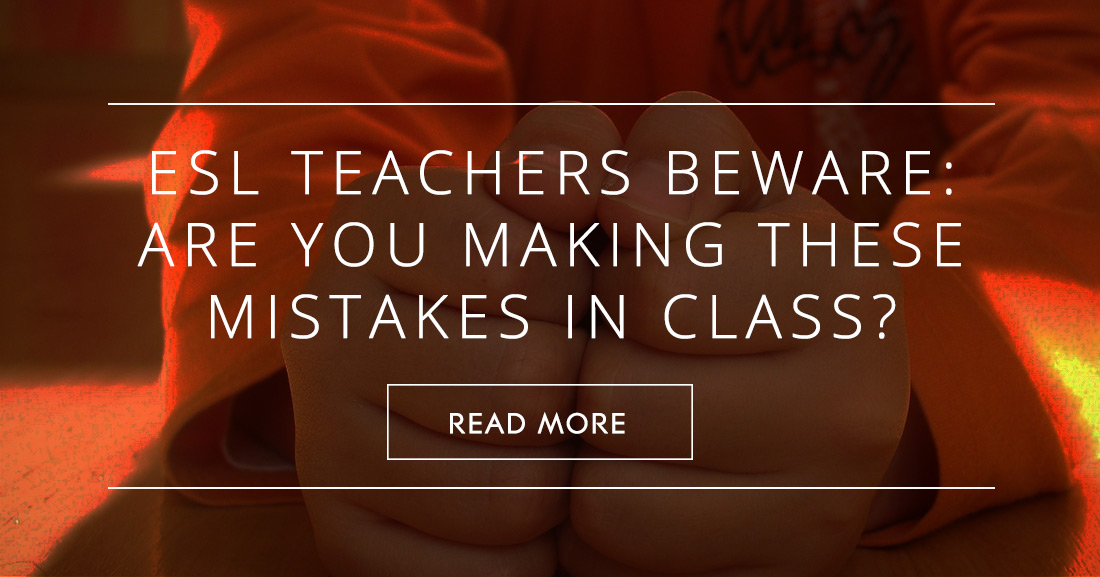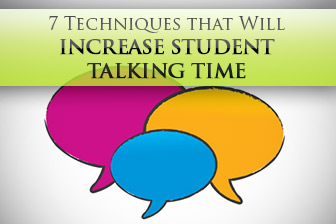ESL Teachers Beware: Are You Making These Mistakes in Class?


There are several reasons why students are quiet, but guess what? One of them is you!
Don’t take this the wrong way. You do a splendid job. But the more you speak, the less they speak. And you don’t want your students to come to class simply to listen to you, right? So here are 7 techniques that will help you speak less and increase student talking time like you never imagined you could.

Is it realistic to expect every student to reply promptly and accurately? Of course not. Some students may be able to fire off a rapid response, but this is not always the case. Some students need time to understand and process what you’ve said/asked. Then, they need time to come up with the right response. So if you want to speak less and get them to speak more, you’ll have to give them those precious seconds they need. If it’s hard for you to wait, count. Five seconds. Or more if you can. It may be hard at first for you and the other students to take those few seconds of silence, but it’ll be worth it.
Have you ever stopped to think that when one student asks you a question, another student may know the answer? Try this technique:
S1: Why is this answer wrong?
T: Mmmm… (looks around the classroom or even directly at another student)
S2: Because “beautiful” is a long adjective and so the comparative is “more beautiful”.
And isn’t it beautiful when your students can help each other, and you don’t have to say a single word?
Quite often we act out role plays with another student. But if you get students into pairs for the role plays and simply walk around to assist, you will speak less, and they will speak more. The same goes for groupwork, whether you have them do a writing task, like write a story together, or a speaking task, like a discussion.
If the instructions are in the coursebook or the worksheet, why must you read them out loud and explain them to the class? If they are pretty straightforward, have a student read them to the class and another explain/rephrase if someone hasn’t understood. This is also a great way to keep eager beavers happy; they get to explain something that is very clear to them, and those who need a little extra help still get the assistance they need.
If you ask students yes/no questions, that’s basically what you’ll get – a yes or a no (and the occasional “maybe”). The more questions you ask with where, why, how often, when, etc…the more they’ll have to speak. But just don’t stop at one question:
T: What kind of music do you listen to?
S1: I listen to rock music.
T: Why?
S1: Because I like it.
T: Where do you listen to it?
S1: I listen to it everywhere: at home, on the bus, on my way to school…
T: (asks S2) How about you, Tommy?
And Tommy should have a pretty good idea of what he can say about his music preferences.
Don’t echo back what students say. Don’t blabber on and on about your weekend. Don’t fill the silence with useless chatter. Of course, you can have relaxed conversations with students, but save those for either the very beginning or the end of class, or what’s even better, the break. During class time, try to focus your efforts on getting them to speak.
When we tell students the answer, they passively receive it. They ask, “What’s this?”, and you say, “It’s a stapler”. It’s too easy for everyone, including you. If students don’t remember a word, for example, try to elicit it from them and feel free to give them clues.
S1: What’s this?
T: Oh! You mean this device we use to staple papers together? What’s this called?
S1: It’s a stapler.
Much too often we tell: Remember when we talked about the different types of weather? We have cloudy, sunny, etc… Don’t tell them what they are if you’ve already seen it in class! Get them to say it!

A special mention must be made regarding how much a student is expected to speak. I subscribe to the theory that in the case of beginners, the ratio of TTT vs. STT should be 50-50, and this percentage should progressively change till you achieve a 30% TTT vs. 70% STT. In very advanced learners, it could even reach a 10-90. You need to figure out what works for each class, but in most cases you should not be talking more than your students.
The one, simple way to get students to speak more is for us to resist the urge to speak. Why don’t teachers shut up? Sometimes it’s because we feel uncomfortable in the silence. Sometimes it’s because we quite simply like to talk, and we enjoy the chatter. But leave the chatter for the teacher’s room.
This is something I still struggle with, as I tend to get too chatty. Can you talk less in class? If so, tell us how you do it!